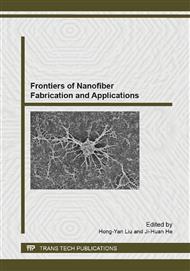[1]
D. H. Reneker; A. L. Yarin, Fong, H.; S. Koombhongse, Bending instability of electrically charged liquid jets of polymer solutions in electrospinning. Journal of Applied Physics. 87 (2000) 4531-4547.
DOI: 10.1063/1.373532
Google Scholar
[2]
Y. Dzenis, Material science: Spinning continuous fibers for nanotechnology. Science. 304 (2004) 1917-1919.
DOI: 10.1126/science.1099074
Google Scholar
[3]
K. Lozano, S. Yang, R. E. Jones, Nanofiber toughened polyethylene composites. Carbon. 42 (2004) 2329-2331.
DOI: 10.1016/j.carbon.2004.03.021
Google Scholar
[4]
F. Ko, M. Gandhi, Producing nanofiber structures by electrospinning for tissue engineering. Nanofibers and nanotechnology in textiles. 22 (2007).
DOI: 10.1533/9781845693732.1.22
Google Scholar
[5]
R. Gopal, S. Kaur, Z. Ma, C. Chan, Ramakrishna, S.; Matsuura, T. Electrospun nanofibrous filtration membrane. Journal of Membrane Science. 281 (2006) 581-586.
DOI: 10.1016/j.memsci.2006.04.026
Google Scholar
[6]
C. Kim, S. H. Park, W. J. Lee, K. S. Yang, Characteristics of supercapaitor electrodes of pbi-based carbon nanofiber web prepared by electrospinning. Electrochimica Acta. 50 (2004) 877-881.
DOI: 10.1016/j.electacta.2004.02.071
Google Scholar
[7]
M. Gandhi, H. Yang, L. Shor, F. Ko, Post-spinning modification of electrospun nanofiber nanocomposite from bombyx mori silk and carbon nanotubes. Polymer. 50 (2009) 1918-1924.
DOI: 10.1016/j.polymer.2009.02.022
Google Scholar
[8]
J. W. S Hearle, Fatigue in fibres and plastics (a review). Journal of Materials Science. 2 (1967) 474-488.
Google Scholar
[9]
H. G. Chae, S. Kumar, Making strong fibers. Science 319 (2008) 908-909.
Google Scholar
[10]
L. R. G. Treloar, Calculations of elastic moduli of polymer crystals: III. Cellulose. Polymer. 1 (1960) 290-303.
DOI: 10.1016/0032-3861(60)90040-9
Google Scholar
[11]
J. H. He, Y. Q. Wan, J. Y. Yu, Application of vibration technology to polymer electrospinning. International Journal of Nonlinear Sciences and Numerical Simulation. 5 (2004) 253-262.
Google Scholar
[12]
Y. Q. Wan, J. H. He, J. Y. Yu, Carbon nanotube-reinforced polyacrylonitrile nanofibers by vibration-electrospinning. Polymer International. 56 (2007) 1367-1370.
DOI: 10.1002/pi.2358
Google Scholar
[13]
Y. Q. Wan, J. H. He, J. Y. Yu, Y. Wu, Electrospinning of high molecule PEO solution. Journal of Applied Polymer. Science. 103 (2007) 3840-3843.
DOI: 10.1002/app.25472
Google Scholar
[14]
Y. Q Wan, F. Ko, Electrospinning of multi-walled carbon nanotubes reinforced bamboo cellulosic fibres. In TAPPI 2009 International Conference on Nanotechnology for the Forest Products Industry, Edmonton, 2009.
Google Scholar
[15]
J. H., He. Effect on temperature on surface tension of a bubble and hierarchical ruptured bubbles for nanofiber fabrication. Thermal Science. 16 (2012) 325-328.
DOI: 10.2298/tsci111111033h
Google Scholar
[16]
J. H. He, H. Y. Kong, R. Yang, Review on fiber morphology obtained by the bubble electrospinning and blown bubble spinning. Thermal Science. 16 (2012).
DOI: 10.2298/tsci1205263h
Google Scholar
[17]
A.F. Spivak, Y.A. Dzenis, D.H. Reneker, A model of steady state jet in the electrospinning process. Mechanics Research Communications 27 (2000) 37-42.
DOI: 10.1016/s0093-6413(00)00060-4
Google Scholar
[18]
Y.Q. Wan, Q. Guo, N. Pan, Thermo-electro-hydrodynamic model for electrospinning process. International Journal of Nonlinear Sciences and Numerical Simulation. 5 (2004) 5-8.
DOI: 10.1515/ijnsns.2004.5.1.5
Google Scholar
[19]
J.H. He, Y.Q. Wan, J.Y. Yu, Allometric scaling and instability in electrospinning. International Journal of Nonlinear Sciences and Numerical Simulation. 5 (2004) 243-252.
DOI: 10.1515/ijnsns.2004.5.3.243
Google Scholar


